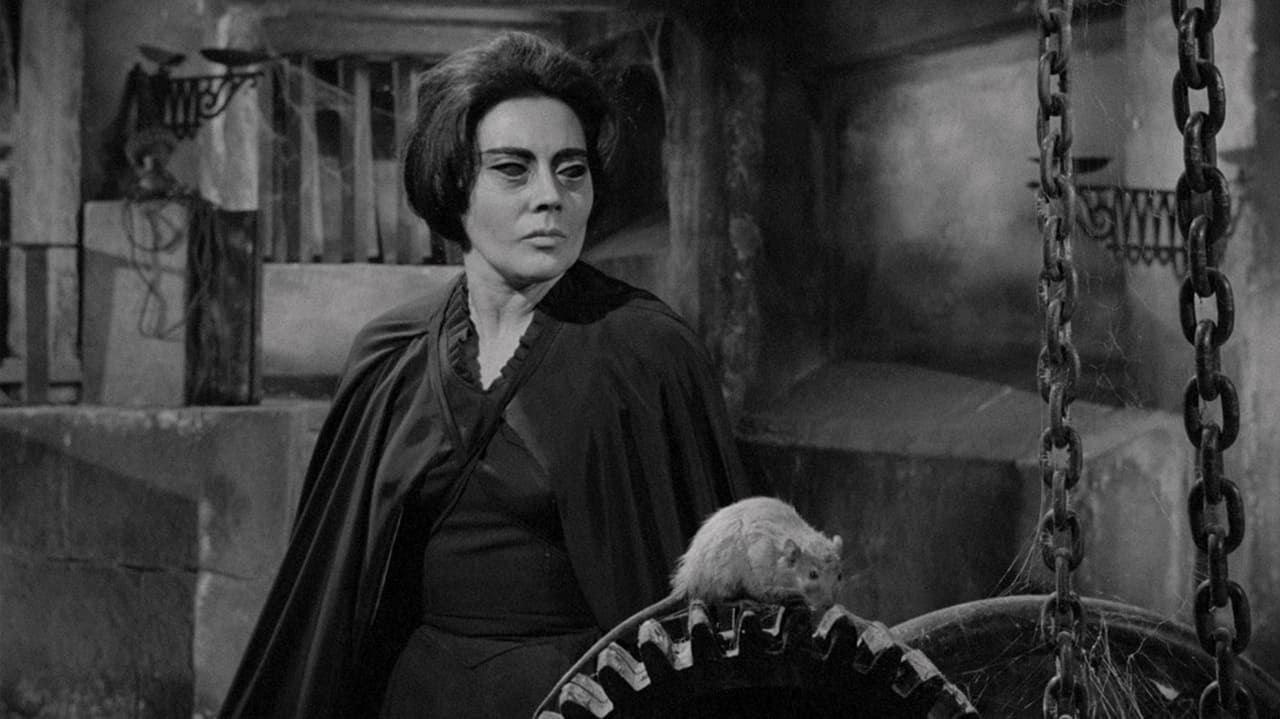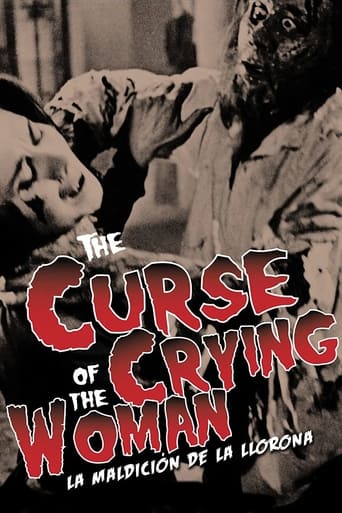



Surprisingly incoherent and boring
n my opinion it was a great movie with some interesting elements, even though having some plot holes and the ending probably was just too messy and crammed together, but still fun to watch and not your casual movie that is similar to all other ones.
View MoreSimple and well acted, it has tension enough to knot the stomach.
View MoreI enjoyed watching this film and would recommend other to give it a try , (as I am) but this movie, although enjoyable to watch due to the better than average acting fails to add anything new to its storyline that is all too familiar to these types of movies.
View MoreThe DVD outfit known as Casa Negra is now a very solid 3 for 3 with me. The first two releases that I saw from these guys, "The Brainiac" (1961) and "The Witch's Mirror" (1960), are both fine Mexican horror films (particularly the latter), featuring pristine-looking restorations and excellent subtitling. And the third DVD that I just watched, "The Curse of the Crying Woman" (1961), is perhaps the best of the bunch. In this one, Abel Salazar, star of "The Brainiac," is teamed with Rosita Arenas, the female lead of "The Witch's Mirror." They play newlyweds who come to visit Rosita's Aunt Selma, played by the very handsome Rita Macedo. What they don't realize is that Selma is a ghoulish witch of sorts who is hell-bent on using Rosita to resurrect an ancient sorceress known as The Crying Woman.... Anyway, it is just remarkable how many elements of classic horror films are present in this one. The picture features a creepy-looking hacienda, rats, spider webs, monstrous hellhounds, a scarred and hulking butler, eerie organ music, several witches, a magic mirror, a crazed attic prisoner, secret passages, a trapdoor and on and on. Shot in gorgeous B&W, the film also features art and set decoration that very effectively convey a miasma of evil. A trippy flashback scene that comes roughly halfway in is truly startling, and there are at least one or two moments guaranteed to make you jump out of your skin. Director Rafael Baledon's direction is impeccable, and the film builds to a tour de force finale that will probably leave you cheering and clapping in your own living room. Oh heck, why mince words? This is a horror masterpiece, plain and simple. Gracias, Casa Negra!
View MoreWhile not quite in the same league as THE BLACK PIT OF DR. M (1958) or THE WITCH'S MIRROR (1960), this is yet another fine addition to the great - and largely unheralded - series of classic Mexican horror films. This was actually the fourth of at least five vintage films about the titular creature (in the last of these, she was even pitted against another Mexican legend - Santo the wrestler!): it would be great if the others were revived - no pun intended - as well somewhere along the line by Casanegra or whomever.Again, the film positively drips with atmosphere and style (belying the miniscule budget on hand) - generally coming off as unmistakably Mexican but also borrowing freely from other horror titles, most notably Mario Bava's seminal BLACK Sunday (1960). As in THE WITCH'S MIRROR - which, incidentally, shared with this film its star Rosita Arenas, producer Abel Salazar (here he essayed the role of the male lead as well) and composer (the ubiquitous Gustavo Cesar Carrion) - weird mirror imagery plays an essential part in the narrative, as does witchcraft, for that matter. The scarred 'monster' of that film as well as THE BLACK PIT OF DR. M, then, is incarnated here not by one but three different figures - The Crying Woman herself, decomposed and awaiting re-animation; her disciple Rita Macedo's hulking and club-footed henchman; and Macedo's once-distinguished husband, whom she has kept locked up for years and who has consequently regressed to a subhuman, animal-like level. Also on hand is a trio of rather skinny-looking Great Danes, which are unleashed from time to time to attack unsuspecting villagers or intruding police officials.Two of its most compelling sequences are those in which Macedo recounts to Arenas and Salazar (individually) the tale of the "Llorona"; the latter has little real purpose, but its depiction of the events is done through brief snippets of scenes (shown in negative) from other Salazar-produced horror films - I immediately noticed the only shot I'm familiar with up to this point, from THE WITCH'S MIRROR, but shots from THE BRAINIAC (1961; which is next in my Halloween horror marathon!) are included as well, as per the Commentary; besides, here we get an unexpected but effective display of sensuality - which is felt again when Arenas (already in the process of replacing the "Llorona") notices Salazar's bloodied hand. Among the film's indelible images are all the scenes in which the eyes of The Crying Woman's disciples turn completely black - an effect seen in the very first shot and which was later lifted by INVASION OF THE BEE GIRLS (1973); Macedo's bat-like swoop towards the camera and Arenas' hallucination (which is as expressionistic as they come, with the night sky being crammed with staring accusing eyes) are also worth mentioning and striking, too, is the distinctive make-up design for each of the 'monsters'.The busy climax - in which Salazar and Carlos Lopez Moctezuma (the henchman) engage in a lengthy and energetic fist-fight, and the long-suffering husband Domingo Soler finally gets even with Macedo, as the hacienda collapses around them - is quite splendid. Also notable here is the lighting when the 'possessed' Arenas attempts to liberate the "Llorona" by removing a stake from her body (a scene which, unfortunately, is absurdly over-extended so as to allow the huge bell in the impressive bell-tower set at the top of the mansion - as important to this film as it was to Hitchcock's VERTIGO [1958] - to chime 12 times!). The film features a generous number of effective shock moments and some rather graphic violence for the time: the scene where a girl - played by Macedo's real-life daughter, billed as Julissa del Llano - is trampled by a carriage; one where the pitiful and half-crazed Soler is brutally whipped by the sadistic Moctezuma, until he retaliates (a scene which is heavily reminiscent of Dwight Frye's tormenting of Boris Karloff in James Whale's FRANKENSTEIN [1931]); and especially the dogs' vicious attack on the two constables (sections of which were reportedly trimmed for export versions).Regrettably, the Audio Commentary for this release turned out to be a major disappointment: not only is there a great deal of dead air on this track, with Michael Liuzza (Casanegra's Vice President, no less!) allowing several of the best scenes to go without comment but, when he does speak, he mainly resorts to biographical details of the various personnel involved!!
View MoreRafael Baledon's "La maldicion de la Llorona" (called "The Curse of the Crying Woman" in English) has the look of a Vincent Price movie, despite everyone speaking Spanish. Portraying a young bride Amelia (Rosita Arenas) and her husband Jaime (Abel Salazar) stopping at the home of her aunt Selma (Rita Macedo), where an evil spirit known as the Crying Woman has taken over, the movie really makes you long for the era. True, the movie's totally corny, but it's as fun as can be. The scenes where Selma's eyes change are actually quite creepy.So, this is a cool example of the movies from that most unique age of cinema (in every place on earth). All that I can say is: muchas gracias, Mexico!
View MoreEnter Gothic Mexico! Easily one of the best Horror films of the classic Mexi-Horror era. This film is oozing with the lush atmosphere, bizarre imagery and beautiful, shadowy photography which many of the Mexican horror classics of this era are known for. Like several other classic Mexican horror films, this one also plays off the the old Mexican folklore tale of Llorona, the weeping ghost/witch of the Mexican countryside. Real horror buffs will see (during the opening scene) a striking similarity between this film and Mario Bava's masterpiece, Black Sunday. The setting, where the Witch lives is actually a old Mexican Hacienda Mansion. I think the scenes where this "Haunted" mansion is depicted rivals that of the old Gothic castles which were typically used as settings in the European classics, mainly the Christopher Lee Dracula films. It just looks different but is creepy as can be. There is also some dreamy, almost psychedelic like sequences also not unusual during this period. Combine all this is the mutated, malformed man kept prisoner in the mansion, the boney flesh-eating hounds, Abel Salazar (Brainiac) playing the heroine and Rita Macedo playing the Witch you have a film any horror fan is not likely to forget.
View More